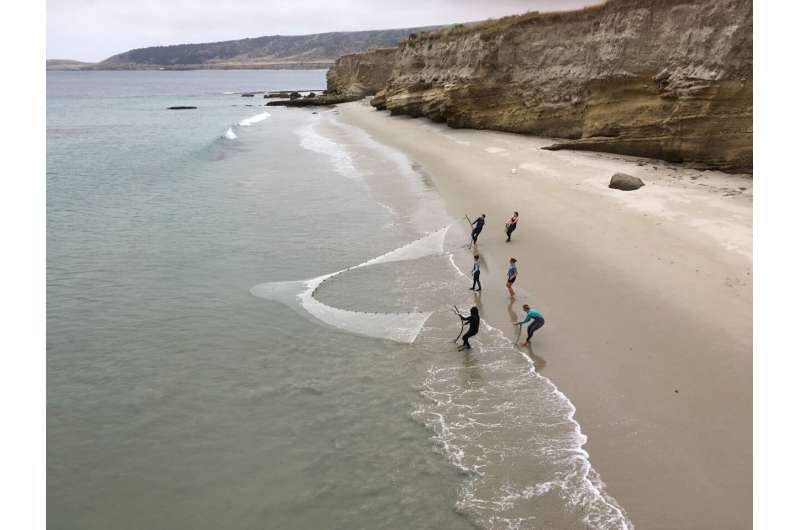This article has been reviewed according to Science X's editorial process and policies. Editors have highlighted the following attributes while ensuring the content's credibility:
fact-checked
peer-reviewed publication
trusted source
proofread
Study using eDNA provides comprehensive picture of wildlife in southern California's waves

What's living beneath the waves? It's a question many Southern California swimmers and surfers ponder when they visit the beach.
Now, thanks to environmental DNA, or eDNA, scientists have the most comprehensive answer ever to that question. A UCLA-led study published in the journal PLOS ONE has identified 80 species of fish and rays living within southern California surf zones—the areas where ocean waves break onto the beach.
"Environmental DNA opens up a wealth of possibilities to monitor our local beach ecosystems," said Paul Barber, a UCLA professor of ecology and evolutionary biology, and the paper's senior author.
Researchers collected ocean samples at 18 sites stretching from the Channel Islands to Catalina. Then they extracted the DNA that animals shed into that water in the form of dead skin, scales and other body parts. Finally, that DNA was matched by species to samples from genetic libraries.
The research turned up a broad array of fish, sharks and rays—including leopard sharks, school sharks, bat rays, round stingrays, opaleye, northern anchovies, flatfish, giant kelpfish and surfperch.
The study's lead author is Zack Gold, who conducted the research as a UCLA doctoral candidate and is now a marine scientist at the Pacific Marine Environmental Lab Ocean Molecular Ecology group of the National Oceanic and Atmospheric Association. Gold said one of the positive findings was that white seabass DNA samples appeared consistently at all of the test sites.
That's significant because white seabass, which has been overfished historically, was the focus of a 1995 California conservation plan. While earlier studies had indicated that the species was recovering slowly, the new study provides evidence that the comeback has been more robust than previously thought.
The researchers also evaluated eDNA as a method for surveying ocean life in comparison to two more traditional approaches: beach seines, in which species are captured with nets, and baited video cameras. They found that eDNA revealed a more comprehensive picture of all the animals living in the surf zones studied: The genetic sampling revealed 58 species that weren't detected by the other methods.
The other research methods still have scientific value, though. For one thing, eDNA doesn't reveal information about the animals' size, age and sex. In addition, eDNA data is vague at best in terms of quantifying how many of each species are present in a given area, but recent advances in the technology could lead to improvements in that regard, too.
As the boundary between land and ocean, surf zones are critical ecological "edges" that are particularly challenging to study due to their turbulent, always-shifting nature, said UC Santa Barbara marine ecologist Jenifer Dugan, a co-author of the paper.
"Remarkably little is known about the fish communities that live in surf zones," Dugan said. "We relied on scientists duck-diving with beach seines and swimming baited cameras out through the surf to learn more about these understudied fish."
While genetic labs are needed to process eDNA samples, even nonscientists like lifeguards and beachgoers can collect the water samples. That means it can be done more cheaply, in more locations and more often—giving conservation science the opportunity to better understand how marine life is affected by oil spills and other pollution events, extreme temperatures and other short-term environmental concerns.
In addition to Gold, the paper's other lead author is McKenzie Koch, who teaches science to children at Ocean Institute, a nonprofit education organization. Koch, who contributed to the paper as an undergraduate at UCLA, said encouraging citizen scientists to participate in research gets them to care more about protecting wildlife.
"If we continue to connect recreation to science, we'll end up with a more motivated generation," she said.
Barber added that researchers at environmental nonprofits like Heal the Bay already are regularly testing water from the region's beaches for unhealthy bacteria. Because that water also contains eDNA, those samples could be useful for long-term monitoring of marine life, which Barber said could be especially informative as the oceans warm due to climate change.
Among other benefits, the study provides the clearest picture yet of ocean life that lives off the coast of Malibu, Santa Monica and other top beach destinations. For example, the research identified evidence of leopard sharks and school sharks in those areas. But Gold said that shouldn't be a reason for beachgoers to stay away, because humans aren't those sharks' prey.
"Most of the fish we're seeing are herbivores or eat invertebrates in the sand," he said. "SUVs on the 405 are a much bigger threat than sharks."
Still, it's nice to know when round rays, which sting when disturbed, are present. Simply shuffling one's feet along the sand can help avoid a painful injury, Gold said, speaking from personal experience.
More information: Zachary Gold et al, A comparison of biomonitoring methodologies for surf zone fish communities, PLOS ONE (2023). DOI: 10.1371/journal.pone.0260903
Journal information: PLoS ONE
Provided by University of Southern California

















